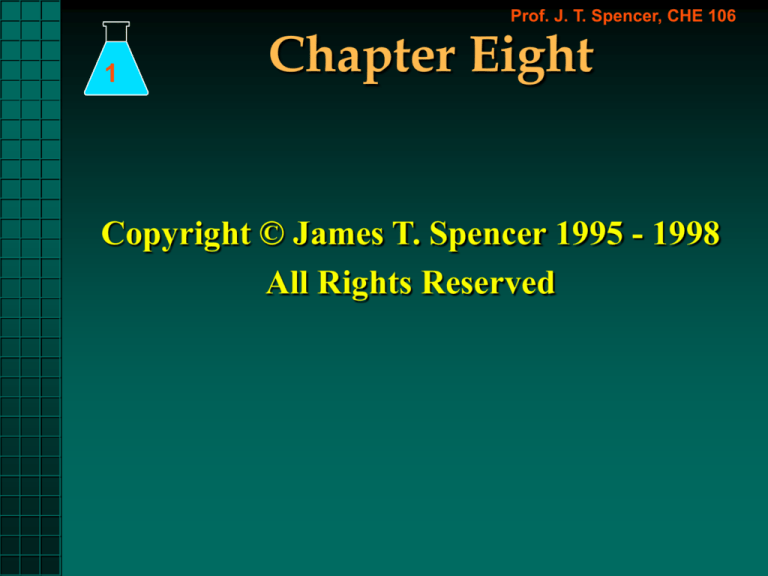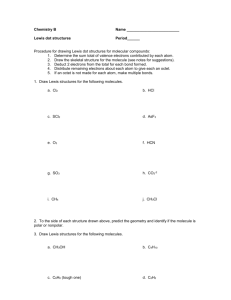
Prof. J. T. Spencer, CHE 106
1
Chapter Eight
Copyright © James T. Spencer 1995 - 1998
All Rights Reserved
Prof. J. T. Spencer, CHE 106
2
Chapter Eight
• Ions versus Molecules.
• Ionic Bonding - Ions which are held together
primarily by electrostatic forces (between
oppositely charged ions).
• Covalent Bonding - sharing of electrons
between atoms in molecules.
• Metallic Bonding - sharing of electrons
between a very large array of atoms in which
the electron are relatively free to move
throughout the large array.
Prof. J. T. Spencer, CHE 106
3
Lewis Structures
• Valence electrons - electrons which
participate in bonding (outer shell
electrons, usually from an unfilled
shell).
• Electron Bookkeeping - Lewis
Symbols (or more commonly Lewis
Structures) keep track of valence
electrons involved in bonding
(ignoring core electrons).
Prof. J. T. Spencer, CHE 106
4
Lewis Structures
•Lewis symbols/structures consist of;
•Elemental Symbol
•a “dot” for each valence electron
•form compounds by sharing or
exchanging electrons to achieve
nearest Noble Gas (group 18)
configuration. Since all noble
gases have 8 valence electrons,
many atoms react to have eight
electrons (octet rule).
Prof. J. T. Spencer, CHE 106
Lewis Structures
5
.
.
.
. . . . . . . . . . . .. . .
Li . Be . B . . C
N
O
.
.
. . : .F. : Ne
.. :
Element
Li
Be
B
C
N
O
F
Ne
Elec. Config. Valence Electrons
1s22s1
1
1s22s2
2
1s22s22p1
3
1s22s22p2
4
1s22s22p3
5
1s22s22p4
6
1s22s22p5
7
1s22s22p6
8
Prof. J. T. Spencer, CHE 106
Lewis Structures
6
• Octet Rule - elements tend to surround
themselves with eight valence electrons
through electron sharing or exchange (to
fill shell). Many exceptions, however.
Electron Exchange - Ionic Bonding
.
Na
..
. Cl :
..
. . -1
.
Na+ + . Cl
. .:
Electron Sharing - Covalent Bonding
. ..
: .F.
..
. .F.:
.. ..
: .F. : .F.:
Prof. J. T. Spencer, CHE 106
Ionic Bonding
7
Na(g) + Cl(g)
Na+1(g) + Cl-1(g)
E° = I1(Na) - EA(Cl) = +146.8 kJ mol-1
Na
r = radius
Cl
Na+1(g) + Cl-1(g)
E
n
e
r
g
y
Na0(g) + Cl0(g)
harpooning
r = radius
Prof. J. T. Spencer, CHE 106
Ionic Bonding
8
• Formation of gaseous ions is Endothermic. Why
does NaCl form if ion formation if endothermic?
Na + Cl
Na+1 + Cl-1
(g)
(g)
(g)
(g)
E° = I1(Na) - EA(Cl) = +146.8 kJ mol-1
• Answer: Lattice Energy - Defined - energy
required to completely separate a solid ionic
compound into its gaseous ions. The reverse
(“condensation” to solid is very exothermic)
Na+1(g) + Cl-1(g)
NaCl(s)
E° = Lattice Energy = -788 kJ mol-1
Prof. J. T. Spencer, CHE 106
9
Cmpd
LiF
LiI
NaF
NaCl
NaI
KF
KBr
KI
MgF2
SrCl2
MgO
Lattice Energy
Lattice Energy
(kJ mol-1)
1024
744
911
788
693
815
682
641
2910
2139
3938
• Endothermic written
from solid to gas and
exothermic from gas to
solid.
• Higher charged ions
have much greater lattice
energies
• The closer the ions can
come together, the larger
the lattice energy.
E=k
k = const.
Q1Q2 Q1 = charge ion 1
Q2 = charge ion 2
d
d = distance
Prof. J. T. Spencer, CHE 106
Ionic Compounds
10
+
-
+
+
+
-
-
+
-
-
+
+
-
-
+
+
+
-
+
-
+
-
+
-
+
-
+
-
-
-
+
Unit Cell
+
-
Cell Face
Prof. J. T. Spencer, CHE 106
11
Ionic Compounds
TiO2 Surface
Prof. J. T. Spencer, CHE 106
12
Ionic Compounds
LiF Lattice
Prof. J. T. Spencer, CHE 106
13
Ionic Compounds
• Why do ionic compounds form?
• Which ionic compounds are stable?
• How do we determine the
stoichiometry of the stable forms
–i.e., MgCl or MgCl2 or MgCl3 ?
Thermodynamics
Use Hess’ Law
and Born-Haber Cycles
Prof. J. T. Spencer, CHE 106
14
Born-Haber Cycle
Law - if a reaction is carried out in a series of steps, H
for the reaction will be equal to the sum of the H’s for the
individual steps.
Hess’s
Prof. J. T. Spencer, CHE 106
15
Born-Haber Cycle
Law - if a reaction is carried out in a series of steps, H
for the reaction will be equal to the sum of the H’s for the
individual steps.
+1
-1
Hess’s
E
n
e
r
g
y
Na (g) +
Cl (g)
Na(g) +
Cl(g)
Na(s) + 1/2 Cl2(g)
HRx
NaCl(s)
Prof. J. T. Spencer, CHE 106
16
Born-Haber Cycle
Law - if a reaction is carried out in a series of steps, H
for the reaction will be equal to the sum of the H’s for the
individual steps.
+1
-1
Hess’s
Na (g) +
E
n
e
r
g
y
EA
I1
Na(g) +
Hsub
Cl (g)
- Lattice
Energy (U)
Cl(g)
U cannot be
determined
directly
BDE
Na(s) + 1/2 Cl2(g)
HRxn = Hsub + I1 + BDE + EA + U
HRx
NaCl(s)
Prof. J. T. Spencer, CHE 106
17
Born-Haber Cycle
Exothermic
HRx = Hvap + I1 + BDE + EA + U
NaCl
Endothermic
Prof. J. T. Spencer, CHE 106
18
Born-Haber Cycle
Why
NaCl and not NaCl2
Na+2(g) + 2 Cl-1(g)
Na+1(g) + 2 Cl-1(g)
E
n
e
r
g
y
I1
Na(g) +
2 Cl(g)
NaCl2(s)
HRx
Na(s) +
Cl2(g)
Prof. J. T. Spencer, CHE 106
19
Born-Haber Cycle
Why
NaCl and not NaCl2
Na+2(g) + 2 Cl-1(g)
Very
Endothermic
I2
- Lattice
Energy (U)
Na+1(g) + 2 Cl-1(g)
E
n
e
r
g
y
I1
EA
Na(g) +
Hvap
Na(s) +
2 Cl(g)
BDE
NaCl2(s)
HRx
Cl2(g)
HRx = Hvap + I1 + I2 + BDE + EA + U
Prof. J. T. Spencer, CHE 106
20
NaCl2
Born-Haber Cycle
Very Endothermic
HRx = Hvap + I1 + I2 + BDE + EA + U
Endothermic
Exothermic
NaCl
HRx = Hvap + I1 + BDE + EA + U
Prof. J. T. Spencer, CHE 106
21
Born-Haber Cycle
larger U offsets
increased
endothermicity
from I2 and EA2
E
n
e
r
g
y
Hf° for MgO
Mg+2(g) +
O-2(g)
Mg+1(g) +
O-1(g)
Mg(g) +
O(g)
HRx
Mg(s) +
1/
2
O2(g)
MgO(s)
Prof. J. T. Spencer, CHE 106
22
Born-Haber Cycle
larger U offsets
increased
endothermicity
from I2 and EA2
Hf° for MgO
Mg+2(g) +
O-2(g)
I2
Mg+1(g) +
EA
O-1(g)
I1
E
n
e
r
g
y
- Lattice
Energy
(U)
EA
Mg(g) +
O(g)
Hvap
Mg(s) +
BDE
1/
2
O2(g)
HRx
MgO(s)
HRx = Hvap + I1 + I2 + BDE + EA1 + EA2 + U
Prof. J. T. Spencer, CHE 106
23
Electronic Config. of Ions
When a positive ion is formed, electrons are
always lost first from the subshell with the
largest n value.
To determinectronic configurations of
Cations, remove the highest energy electrons
(usually the last one added EXCEPT for
transition metal ions - which have NO
n(max)s electrons).
25Mn
25Mn+1
4s
3d
3d
3d
3d
3d
4p
4p
4p
Prof. J. T. Spencer, CHE 106
24
Ionic Radii
• Sizes of ions determines stability and packing
arrangements (structures) of ionic compounds.
• Size depends upon Zeff and the total number of
electrons of the ion.
– Cations are smaller than the neutral atoms
– Anions are larger than the neutral atoms
– size of Ions of the same charge increases down
and L.
• Isoelectronic Series - ions with the same number of
electrons (although different charges):
N-3 = O-2 = F-1 = Ne = Na+1 = Mg+2 = Al+3 = 10 elec.
Prof. J. T. Spencer, CHE 106
Ionic Radii
25
r
a
d
i
u
s
• Isoelectronic series - ions with the same number
of electrons
Se-2
Br
-2
S
ClO-2
F-
K+
Na+
Li+
Mg+2
Be+2
Al+3
Ca+2
Sc+3
Ti+4
Rb+
Sr+2
Y+3 +4
Zr
smaller w/ incr + charge
smaller with smaller max n
atomic number
Prof. J. T. Spencer, CHE 106
26
Covalent Bonding
• Atoms may achieve noble gas configurations by
sharing electrons
. ..
: .F.
..
. .F.:
.
4 H . + . C. .
.. ..
: .F. : .F.:
H
..
.. H
H .. C
..
H
Each atom achieves an outer shell with 8 electrons (at least)
Lewis structures show this electron sharing
Prof. J. T. Spencer, CHE 106
27
Covalent Bonding
• Wave function (wave
properties)
• Can “constructively” and
“destructively add waves
(just like ripples on a
pond).
1s orbital
2
0 radius
H atom
1
Move together to
overlap waves
0 radius
1s orbitals
2
H atom
2
0 radius
Prof. J. T. Spencer, CHE 106
28
Covalent Bonding
Destructive
Addition of
Waves
(out of phase)
2
H atom
2
H atom
1
0
Constructive
Addition of
Waves
(in phase)
radius
0
2
H atom
2
H atom
1
0
radius
0
Prof. J. T. Spencer, CHE 106
29
Covalent Bonding
s orbital - in-phase addition (bonding)
+
s orbital - out-of-phase addition (antibonding)
+
Prof. J. T. Spencer, CHE 106
30
Covalent Bonding
p orbital - in-phase addition (bonding)
+
p orbital - out-of-phase addition (antibonding)
+
Prof. J. T. Spencer, CHE 106
31
Multiple Bonds
• Bond Order (bo) denotes how many electron pairs
are shared between two atoms;
– single bond (bo = 1) has one shared electron
pair. longest
– double bond (bo = 2) has two shared electron
pair.
– triple bond (bo = 3) has three shared electron
pair. shortest
Single
.. ..
: .F. : .F.:
F = 1s22s22p5
Double
.. ..
::
O
.. O
..
O = 1s22s22p4
Triple
: N ::: N:
N = 1s22s22p3
Prof. J. T. Spencer, CHE 106
32
Polarity and Electronegativity
• Electrons shared equally between like atoms is a
non-polar covalent bond (i.e., H2, F2, O2, etc...).
• Electrons may be unequally shared due to
differences in Zeff between unlike nuclei (i.e., HF).
Referred to as polar covalent bonding.
• Electron density shifts toward the greater Zeff
nuclei.
• Electronegativity - used to estimate the polarity of
a bond - the ability of an atom to attract electrons
to itself.
Prof. J. T. Spencer, CHE 106
Electronegativity
33
metals
metalloids
non-metals
1
2
3
1H
4
5
6
7
8
9
10
11
F EN (highest) = 4.0
Cs EN (lowest) = 0.7
12
13
14
15
16
17
Higher
EN
18
2 He
3 Li
4 Be
5B
6C
7N
8O
9F
10 Ne
11 Na
12 M g
13 Al
14 Si
15 P
16 S
17 Cl
18 Ar
19 K
20 Ca
21 Sc
22 Ti
23 V
24 Cr
25 M n
26 Fe
27 Co
28 Ni
29 Cu
30 Zn
31 Ga
32 Ge
33 As
34 Se
35 Br
36 Kr
37 Rb
38 Sr
39 Y
40 Zr
41 Nb
42 M o
43 Tc
44 Ru
45 Rh
46 Pd
47 Ag
48 Cd
49 In
50 Sn
51 Sb
52 Te
53 I
54 Xe
55 Cs
56 Ba
57 La
72 Hf
73 Ta
74 W
75 Re
76 Os
77 Ir
78 Pt
79 Au
80 Hg
81 Tl
82 Pb
83 Bi
84 Po
85 At
86 Rn
87 Fr
88 Ra
89 Ac
104 Unq 105 Unp 106 Unh 107 Ns
108 Hs
109 M t
69 Tm
70 Yb
71 Lu
Lower
EN
58 Ce
59 Pr
60 Nd
61 Pm
62 Sm
63 Eu
64 Gd
65 Tb
66 Dy
67 Ho
68 Er
90 Th
91 Pa
92 U
93 Np
94 Pu
95 Am 96 Cm
97 Bk
98 Cf
99 Es
100 Fm 101 Md 102 No
103 Lr
Prof. J. T. Spencer, CHE 106
Bond Polarity
34
• The larger the difference in EN between the two
bonded atoms, the more unequal the electron
sharing.
• Bonds with unequal electron sharing are a polar
bonds with the higher EN atom “holding” the
greater electron density.
IONIC
F
F
EN = 0
Element
F
N
B
Li
N
F
EN = 1.0
B
F
EN = 2.0
Electronegativity
4.0
3.0
2.0
1.0
Li
F
EN = 3.0
More Polar
Prof. J. T. Spencer, CHE 106
35
Bond Polarity
H
F
EN = 4.0 - 2.1 = 1.9
Polar Covalent Bond
Classify the Bonds (give EN):
S
S non-polar
B
Cl polar covalent
P
F polar covalent
P
Cl polar covalent
P
O polar covalent
Li
F ionic
N
F polar covalent
O
O non-polar
0
1.0
1.9
0.9
1.4
3.0
1.0
0.0
Element
F
O
N
C
B
Li
P
Cl
Br
EN
4.0
3.5
3.0
2.5
2.0
1.0
2.1
3.0
2.8
Prof. J. T. Spencer, CHE 106
36
Drawing Lewis Structures
• Lewis Structure describe many properties of
molecules. To draw Lewis structures;
– Sum the valence electrons for all atoms
– Write symbols for the atoms and connect
atoms in correct arrangement (with at least a
single bond)
– Complete the octets of the atoms bonded to the
central atom (with some exceptions)
– Place any remaining electrons on the central
atom
– If short electrons to gain central atom’s octet,
try using multiple bonds.
Prof. J. T. Spencer, CHE 106
Lewis Structures
37
.
.
.
. . . . . . . . . . . .. . .
Li . Be . B . . C
N
O
.
.
. . : .F. : Ne
.. :
Element
Li
Be
B
C
N
O
F
Ne
Elec. Config. Valence Electrons
1s22s1
1
1s22s2
2
1s22s22p1
3
1s22s22p2
4
1s22s22p3
5
1s22s22p4
6
1s22s22p5
7
1s22s22p6
8
Prof. J. T. Spencer, CHE 106
38
Formal Charge
• Bookkeeping of valence electrons
– all the unshared electrons are assigned to the
atom on which they are found
– Half of the bonding electrons are assigned to
each atom in a bond
– Formal charge - the number of valence
electrons on the isolated atom minus the
number of electrons assigned to the atom in
the Lewis structure.
formal ch. = [atomic valence e-] - [assigned e-]
• The best Lewis structure (most stable) will be the
one with the smallest formal charges and the one
in which formal negative charges reside on the
most electronegative atoms.
Prof. J. T. Spencer, CHE 106
39
Formal Charge
B in neutral atom has 3 valence electrons
in [BH4]-, B assigned 4 electrons
formal charge on B = -1
Atom
N
O (R)
O (L)
H
-1
H B H
H
Neutral Assigned Formal Ch.
5
5
0
6
6
0
6
7
-1
-1
O N O
Prof. J. T. Spencer, CHE 106
40
Lewis Structures
• Best way to learn Lewis structures is PRACTICE!
• Example (in class):
– PCl3
– PH3
– H2O
“Normal”
– HClO2
– SeCl2
• [BH4]• [NO2]• [CO3]-2
–SO3
–HCN
Charged
Multiple Bonding
Prof. J. T. Spencer, CHE 106
41
Lewis Structure: PCl3
= electron pair
(1) Sum Valence Electrons:
P =1x5
=5
Cl = 3 x 7
= 21
Total
= 26 electrons = 13 pairs
(2) Write symbols and include atom connections:
Cl
P Cl
Cl
(3) Complete Octets and place all remaining electrons:
Cl
P Cl
Cl
(4) Check (including formal charges).
Prof. J. T. Spencer, CHE 106
42
Lewis Structure: PH3
= electron pair
(1) Sum Valence Electrons:
P =1x5
=5
H =3x1
=3
Total
= 8 electrons = 4 pairs
(2) Write symbols and include atom connections:
H
P H
H
(3) Complete Octets and place all remaining electrons:
H
P
H
H
(4) Check (including formal charges).
Prof. J. T. Spencer, CHE 106
43
Lewis Structure: H2O
= electron pair
(1) Sum Valence Electrons:
H =2x1
=2
O =1x6
=6
Total
= 8 electrons = 4 pairs
(2) Write symbols and include atom connections:
H
O
H
(3) Complete Octets and place all remaining electrons:
H
O
H
(4) Check (including formal charges).
Prof. J. T. Spencer, CHE 106
44
Lewis Structure: HClO2
(1) Sum Valence Electrons:
= electron pair
Cl = 1 x 7
=7
O =2x6
= 12
H =1x1
=1
Total
= 20 electrons = 10 pairs
(2) Write symbols and include atom connections:
H Cl O
O
(3) Complete Octets and place all remaining electrons:
H Cl O
O
(4) Check (including formal charges).
Prof. J. T. Spencer, CHE 106
45
Lewis Structure: SeCl2
= electron pair
(1) Sum Valence Electrons:
Se = 1 x 6
=6
Cl = 2 x 7
= 14
Total
= 20 electrons = 10 pairs
(2) Write symbols and include atom connections:
Cl
Se
Cl
(3) Complete Octets and place all remaining electrons:
Cl Se Cl
(4) Check (including formal charges).
Prof. J. T. Spencer, CHE 106
46
Lewis Structure: [BH4]-
= electron pair
(1) Sum Valence Electrons:
B =1x3
=3
H =4x1
=4
charge
=1
Total
= 8 electrons = 4 pairs
(2) Write symbols and include atom connections:
H
-1
H B H
H
(3) Complete Octets and place all remaining electrons:
H -1
H B H
H
(4) Check (including formal charges).
Prof. J. T. Spencer, CHE 106
47
Lewis Structure: NO2
-
(1) Sum Valence Electrons:
= electron pair
N =1x5
=5
O =2x6
= 12
charge (-1)
=1
Total
= 18 electrons = 9 pairs
(2) Write symbols and include atom connections:
-1
O N O
(3) Complete Octets and place all remaining electrons:
-1
O N O
(4) Check (including formal charges).
Prof. J. T. Spencer, CHE 106
48
Lewis Structure: CO3
-2
(1) Sum Valence Electrons:
= electron pair
C =1x4
=4
O =3x6
= 18
charge (-1)
=2
Total
= 24 electrons = 12 pairs
(2) Write symbols and include atom connections:
-2
O C O
O
(3) Complete Octets and place all remaining electrons:
-2
O C O
O
(4) Check (including formal charges).
Prof. J. T. Spencer, CHE 106
49
Lewis Structure: SO3
-2
(1) Sum Valence Electrons:
= electron pair
C =1x6
=6
O =3x6
= 18
charge (-1)
=2
Total
= 26 electrons = 13 pairs
(2) Write symbols and include atom connections:
-1
O S O
O
(3) Complete Octets and place all remaining electrons:
-1
O S O
O
(4) Check (including formal charges).
Prof. J. T. Spencer, CHE 106
50
Lewis Structure: HCN
(1) Sum Valence Electrons:
= electron pair
C =1x4
=4
N =1x5
=5
H =1x1
=1
Total
= 10 electrons = 5 pairs
(2) Write symbols and include atom connections:
H C
N
(3) Complete Octets and place all remaining electrons:
H C
N
(4) Check (including formal charges).
Prof. J. T. Spencer, CHE 106
Resonance Structures
51
• Certain molecules cannot adequately be
described using a single Lewis structure
– Ozone is perfect example
– takes two Lewis structures to describe ozone
O
O
O
O
O
O
Prof. J. T. Spencer, CHE 106
Resonance Structures
52
• If the below description of ozone is correct, how is
this possible?
– Double bond is shorter than single bond so
molecule would be lopsided
O
O
O
O
O
O
Prof. J. T. Spencer, CHE 106
53
Resonance Structures
• When several possible Lewis structures can be
written which vary only in electron arrangement
(not atom connections), each possible structure is
a resonance structure (connected by double
headed arrows).
• The molecule “exists” as a weighted blend of the
possible Lewis structures
F
F
F
F
B
B
B
F
F
F
F
F
Prof. J. T. Spencer, CHE 106
54
Resonance Structures
• Resonance is of crucial importance in organic
chemistry
– primary group showing resonance is the
aromatics
– aromatics are based on benzene
Prof. J. T. Spencer, CHE 106
55
Octet Rule Exceptions
• Exceptions to the Octet Rule:
– Molecules with odd number of electrons (i.e.,
ClO2, NO2, NO, etc...).
– Molecules in which the atom has less than an
octet (i.e., BF3, H2, etc...).
– Molecules in which an atom has more than an
octet (i.e., PCl5, [ICl4]-1, XeOF4, etc...).
–only possible for period 3 and beyond
elements (requires n = 3 or greater)
Prof. J. T. Spencer, CHE 106
56
Octet Rule Exceptions
• Exceptions to the Octet Rule:
– Molecules with odd number of electrons (i.e.,
ClO2, NO2, NO, etc...).
• Complete pairing of electrons is impossible
– Molecules in which the atom has less than an
octet (i.e., BF3, H2, etc...).
• Most encountered in molecules of Boron
and Beryllium
• allows the B or Be to bond with another
atom using a coordinate covalent bond
Prof. J. T. Spencer, CHE 106
Octet Expansions
57
PCl5
P=1x5 =5
Cl = 5 x 7 = 35
40 e- = 20 e- pairs
Cl
P
XeOF4
Xe = 1 x 8 = 8
O=1x6 =6
F = 4 x 7 = 28
21 e- pairs
-1
Cl
Cl
ICl4-1
I=1x7=7
4x7
= 28
charge = 1
18 e- pairs
Cl
Cl
Cl Cl
Cl I Cl
O
F
F
Xe
F
F
Unshared electron pairs on central atom
Prof. J. T. Spencer, CHE 106
58
• Practice:
– CHCl3
– NH4+
– XeO4
– HNO2
– C2N2
– SCl2
– ClF3
Lewis Structures
13 prs
4 prs
16 prs
9 prs
9 prs
10 prs
14 prs
Prof. J. T. Spencer, CHE 106
59
• Practice:
– CHCl3
– NH4+
– XeO4
– HNO2
– C2N2
– SCl2
– ClF3
Lewis Structures
13 prs
4 prs
16 prs
9 prs
9 prs
10 prs
14 prs
Cl
H C Cl
Cl
H +1
H N H
H
Prof. J. T. Spencer, CHE 106
60
• Practice:
– CHCl3
– NH4+
– XeO4
– HNO2
– C2N2
– SCl2
– ClF3
Lewis Structures
13 prs
4 prs
16 prs
9 prs
9 prs
10 prs
14 prs
Cl
H C Cl
Cl
H +1
H N H
H
O
O
H N O
O Xe O
O
Prof. J. T. Spencer, CHE 106
Lewis Structures
61
• Practice:
– CHCl3
– NH4+
– XeO4
– HNO2
– C2N2
– SCl2
– ClF3
N
C
13 prs
4 prs
16 prs
9 prs
9 prs
10 prs
14 prs
C
N
Cl
H C Cl
Cl
H +1
H N H
H
O
O
H N O
O Xe O
O
Cl
S Cl
F
Cl F
F
Prof. J. T. Spencer, CHE 106
62
Bond Strengths
• Stability of molecules is related to the strengths of
the bonds within the molecules
• Bond strengths can be determined
thermochemically
– Bond Dissociation Energy (BDE, H)
F-F (g)
2 . F (g)
H = 155 kJ mol-1
O=O (g)
2. O. (g)
H = 495 kJ mol-1
NN (g)
(g)
H = 941 kJ mol-1
.
2. N
.
Prof. J. T. Spencer, CHE 106
63
Bond Strengths
• BDE for diatomic molecules may be measured
directly since only one bond exists within the
molecule.
• For polyatomic molecules (with many bonds), its
difficult to determine the BDE directly so an
average BDE is typically used.
– Atomization Reactions:
H
.
.
.Si. (g) + 4 H (g) H = 1292 kJ mol-1
H Si H (g)
.
H
ave BDE (CH)= 1292 kJ mol-1/ 4= 323 kJ mol-1
•BDEs are endothermic (positive)
Prof. J. T. Spencer, CHE 106
64
Bond Dissociation Energies
• Larger BDE’s generally lead to lower reactivity.
• BDE’s follow bond order (b.o. and BDE 3 > 2 > 1).
Bond
C-C
C=C
CC
N-N
N=N
NN
C-N
C=N
CN
Ave. BDE (kJ mol-1)
348
614
839
391
418
941
293
615
891
BO
1.0
2.0
3.0
1.0
2.0
3.0
1.0
2.0
3.0
Prof. J. T. Spencer, CHE 106
65
Bond Energies
• Bond energies may be used to estimate H for
reactions where bonds are broken or formed.
– Determine which bonds are broken
(endothermic)
– Sum the BDE for these bonds
– Determine which bonds are formed
(exothermic)
– Sum the BDE for these bonds
– Estimate H by;
H = (BDE bonds broken) - (BDE bonds formed)
Prof. J. T. Spencer, CHE 106
66
H estimates from BDE’s
estimate H for the reaction:
H
H
H - C - O - H + H - Br
H - C - Br + H - O - H
H
H
H = (BDE bonds broken) - (BDE bonds formed)
H = (BDE C-O + BDE H-Br ) - (BDE C-Br + BDE O-H)
H = (358 + 366) - (276 + 463) kJ mol-1
H = (724) - (739) kJ mol-1
H = -15 kJ mol-1
Prof. J. T. Spencer, CHE 106
67
H estimates from BDE’s
estimate H for the reaction:
H
H
C=C + H-O-O-H
H H
H-O-C-C-O-H
H H
H
H
H = (BDE bonds broken) - (BDE bonds formed)
Prof. J. T. Spencer, CHE 106
68
H estimates from BDE’s
estimate H for the reaction:
H
H
C=C + H-O-O-H
H H
H-O-C-C-O-H
H H
H
H
H = (BDE bonds broken) - (BDE bonds formed)
H = (BDE C=C + BDE O-O ) - (2(BDE C-O) +
BDE C-C)
H = (614 + 146) - (2(358) + 348) kJ mol-1
H = (760) - (1064) kJ mol-1
H = -304 kJ mol-1
Prof. J. T. Spencer, CHE 106
69
Bond Lengths
• As the number of bonds between two atoms
increases (greater bond order), the bond becomes
shorter and stronger.
Bond
C-C
C=C
CC
N-N
N=N
NN
C-N
C=N
CN
Ave. BDE (kJ mol-1)
348
614
839
391
418
941
293
615
891
BO
1.0
2.0
3.0
1.0
2.0
3.0
1.0
2.0
3.0
Bond Length
1.54
1.34
1.20
1.47
1.24
1.10
1.43
1.38
1.16
Prof. J. T. Spencer, CHE 106
70
End Chapter Eight
• Ionic Bonding
• Octet Rule and Lewis Symbols and Lewis
Structures
• Hf° for ionic compounds - esp. Lattice energies
and Born-Haber cycles.
• Ionic Radii
• Covalent Bonding
• Bond Polarity and electronegativity
• Lewis Structures (incl. resonance structures,
formal charge, etc...)
• Covalent Bond Lengths and Strengths






